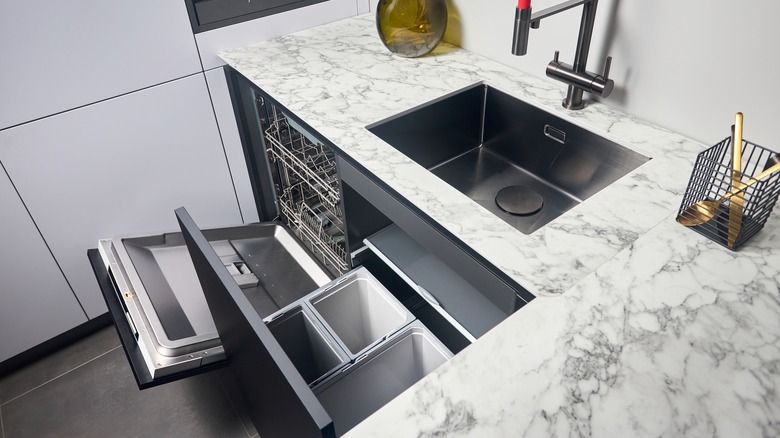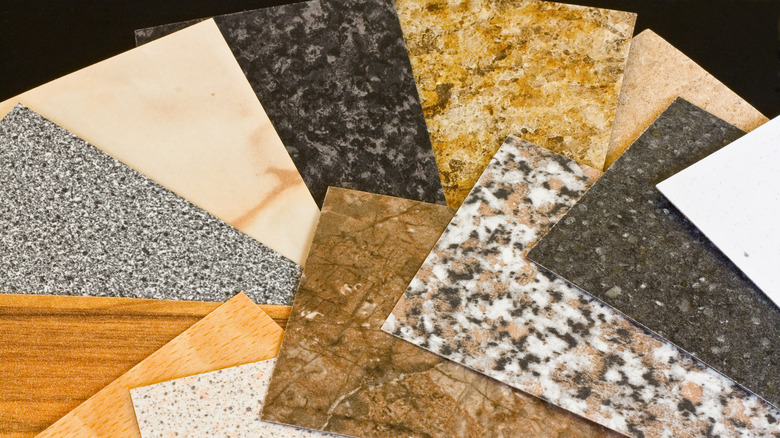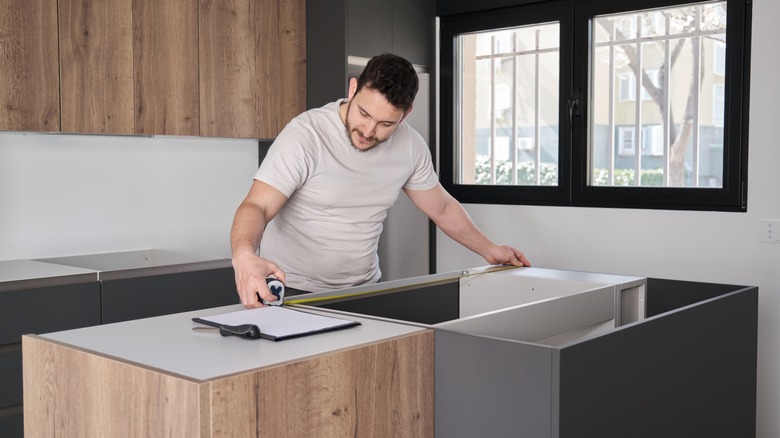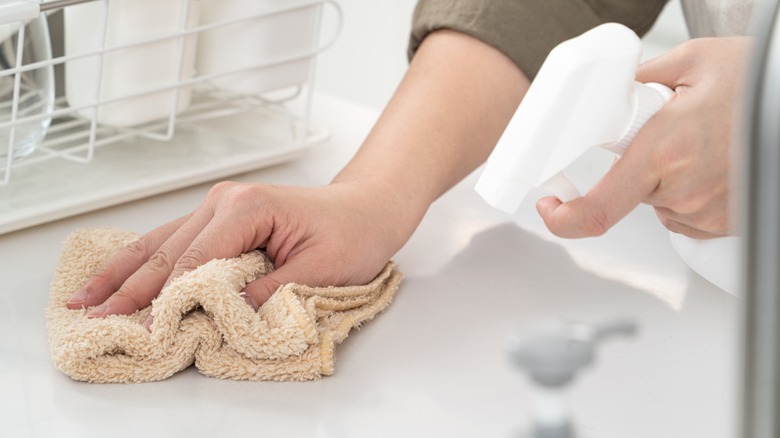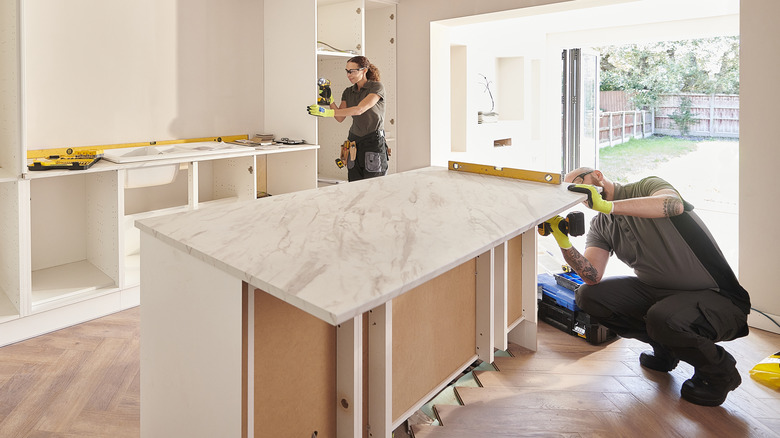Crucial Mistakes Everyone Makes When Buying Laminate Countertops
There are several reasons homeowners look to installing laminate countertops when updating their kitchens. With so many designs and colors, there's no doubt you can find one that fits your home's aesthetic. Some options even mimic the look of quartz, granite, and marble without the expensive price tag of the genuine stones. Not only is laminate budget-friendly, but it tends to be low-maintenance and nearly stain-resistant, too. The non-porous surface prevents oils, dirt, and moisture from penetrating, making it almost impossible to stain. Unlike many other materials, laminate is relatively DIY-friendly and has straightforward installation procedures that DIYers can handle.
Although there are several benefits to choosing this type of kitchen counter surface, there are crucial mistakes everyone makes when buying laminate countertops. Factors like your budget, taking your time selecting the right design, and double-checking your measurements can make or break the replacement process. So, to get the most out of your new counters, it's vital to be prepared in order to avoid preventable mistakes and ensure it lasts for the long haul.
Not testing colors in your home first
When purchasing new countertops, a common mistake people make is not testing the colors or designs in their homes first. While it may seem minor, it can significantly impact the overall look of your space. What you may love in a showroom may not necessarily complement your home's style and decor. Failing to test in your kitchen can cause disappointment and result in an expensive mismatch you'll end up needing to fix. Counters take up most of your kitchen, so you'll want to ensure you take plenty of time and be confident in your final choice.
Before you commit, request three or four samples from the store to bring home. These small swatches will allow you to see the colors in your kitchen lighting next to your wall paint, decor, and other elements. Place the samples against the counters, backsplash, cabinets, and flooring to get a sense of how they'll harmonize. It helps to do the prior steps at varying hours of the day to see how different lighting impacts the look. Keep your overall aesthetic in mind. Are you searching for a modern, minimalistic, or rustic feel? Ensure the design aligns with your ultimate vision.
Not getting the proper measurements
One of the best aspects of choosing laminate countertops over other materials is its budget-friendly cost. However, improper measurements can take an inexpensive installation process and turn it into a costly headache. You risk overordering or underordering laminate sheets by not having the exact sizing mapped out. Purchasing too much material means you'll have unnecessary expenses, while too little results in delays and additional costs. Even a slight mistake can result in ill-fitting counters with crooked edges or small, but unsightly, gaps.
Taking thorough measurements may be time-consuming, but it'll actually save you more time — and stress — in the long run. Make sure you're using a precise tape measure to record the length and width of your existing counters. Jot down exactly what the tape measure says, as rounding up or down could result in incorrect sizing. You'll also want to ensure you account for overhang and appliances (typically 1 to 2 inches) and factor it into the overall measurements. Double or even triple-check before you finalize the numbers, measuring each surface at least twice to rule out inaccuracies.
Neglecting to budget
While laminate countertops are more cost-effective than options like granite or quartz, it's crucial not to overlook the importance of setting a budget. Expenses can add up quickly in any home improvement project, so you'll want to do what you can to avoid overspending. Remember, not all laminate counters are created equal, so by knowing your ideal price range, you can find the perfect balance between affordability and quality. Plus, you can better anticipate other expenses that may come up during the installation process, like edge treatments, backsplashes, and any other features you desire. Don't forget to factor in any labor costs if hiring a contractor!
Explore different laminate options and what each of the costs are. Look for local suppliers or home improvement stores that offer competitive prices. If hiring a contractor, get quotes from several professionals to allocate accordingly. Once you have an idea of what the costs of materials and labor will be, it's a good idea to set aside a small percentage (typically around 10%) as a contingency fund. This way, you're prepared for unexpected adjustments during the project.
Choosing based on looks alone
Although you may fall in love with a certain color or style, you may want to wait before fully committing. There are different types of laminates to choose from in varying price ranges and functionality. Inferior materials may chip or scratch more easily than higher-quality options, like high-pressure laminates (HPLs). What may be less expensive initially could cost you in the long run. HPLs are more of a high-end laminate countertop option, offering better resistance to heat, chemicals, and overall wear and tear. Additionally, some laminates may lack depth and realism, so pay close attention to the details and ask to see a bigger sample if you're unsure.
Before you get attached to a particular design, research the different types of laminates and choose one that can withstand your daily kitchen use. HPLs are typically the go-to, as they're built to be more durable than their lower-cost counterparts. There are several different brands to choose from, including Pionite HPL, Wilsonart, and Formica 180fx, each with its own pros and cons. If you struggle with knowing which route to take, share your concerns with a professional specializing in countertops. They can guide you toward the proper laminate material based on your budget, lifestyle, and design preferences.
Disregarding durability altogether
Laminates are fairly resilient, but certain practices can compromise their strength, leading to bubbling, warping, and chipping. This material is boasted as being scratch and burn-resistant, but this doesn't mean they aren't susceptible to damage all together. While this surface can handle small spills that are taken care of quickly, repeated exposure to high temperatures can destroy the bonding or even melt the laminate itself. While durable, any harsh movements, like using a meat tenderizer or using a knife directly on the surface, can cause scratches or cracking.
Taking precautions in the kitchen is crucial to keep your counters looking their best. You never want to set any hot objects, such as a pan that's been in the oven, directly on the surface. Always use some barrier, like a pot holder, to shield the excess heat. The dishwasher is another area where high temperatures could be an issue. Once a cycle finishes, make sure to let it cool down. Otherwise, the steam will release heat and moisture, quickly damaging the material. Because these countertops can get scratched by sharp objects, always use a cutting board or block when chopping food.
Forgetting about maintenance
Most people know about the low-maintenance and stain-resistant qualities of laminate countertops, but what they may not realize is that they still require special maintenance and care. While laminates do resist discoloration from most spills, the material isn't completely stain-proof either. Without proper maintenance, scratches, heat damage, and messes can accumulate over time, compromising the countertop's appearance and longevity. Plus, using the wrong cleaning products can cause discoloration or dullness as well.
Wipe up stains immediately, and ensure you don't forget to stick to a regular cleaning routine. Rough rags or abrasive cleaners can harm the surface, sometimes even causing irreversible scratches or deterioration. Avoid using anything acidic or alkaline to prevent the finish from dulling over time. It's best to use a mild, soapy water mixture and a soft cloth to clean, but a neutral pH cleaner is okay to use on tough spots. Laminates are also susceptible to water damage, so make sure to dry your counters thoroughly after cleaning or if you spill anything on them. It's also important to keep up with caulking and sealing any exposed edges that can allow moisture to seep in.
Not hiring the right contractor for the job
If you choose not to go the DIY route, you'll want to do your due diligence when choosing the right contractor. Skilled laborers streamline the process, reducing some of the headaches of any home renovation project. However, hiring the wrong professional can take your beautiful countertop and make it look unsightly with improper installation. As the client, it helps to know your vision before you start hiring. Consider what goals you have in mind, what your envisioned end result looks like, and any other desired amenities. However, a professional can help steer you in the right direction if you're unsure about any of the above.
While researching can be somewhat painstaking, it'll save you a lot more stress down the line. Collect at least three estimates, though more quotes will provide more clarity on how companies compare. Not only can you gauge costs, but you can get an idea of the caliber of work each contractor offers. Don't stop your investigating there, however. Look up reviews and see if they can provide testimonials from previous clients. It helps to ask for photos of previous projects they've worked on so you can have a clearer idea of their experience and what they can achieve cosmetically. You can also typically find videos and pictures on social media platforms or their website, though it doesn't hurt to request specific footage.
Consider the long-term value
Installing new counters is a large project that will change your kitchen's entire look and feel. Before you decide to commit to laminate countertops, it's essential to understand how they affect your home's resale value. While the affordability of this material is a massive pro for most, it, unfortunately, means they likely won't boost your property's worth. Laminates last 15 to 20 years, depending on how well you maintain them, while natural stones, like granite, can last over 100 years with the right care. So, take some time to consider all the factors.
First, consider what your priorities are. If you found your forever home and don't plan on moving anytime soon, then your personal preferences, functionality, and budget matter more than the resale value. However, if you anticipate selling soon, weigh the cost of laminate against potential gains. If you're unsure what the future holds, but are leaning toward laminate countertops, patterns that mimic natural stone or wood tend to be more sought out. Choose a high-quality finish, and do your best to keep your countertops well-maintained to get the most value out of them.
